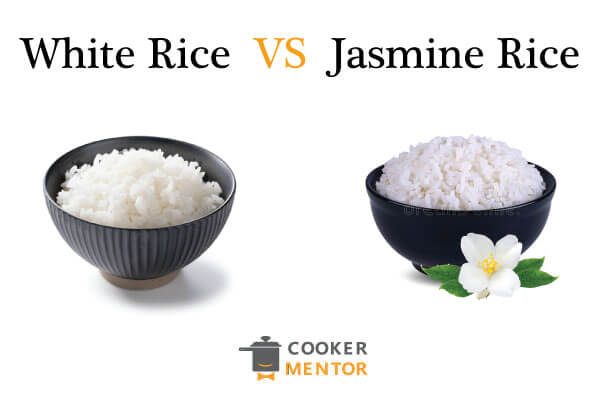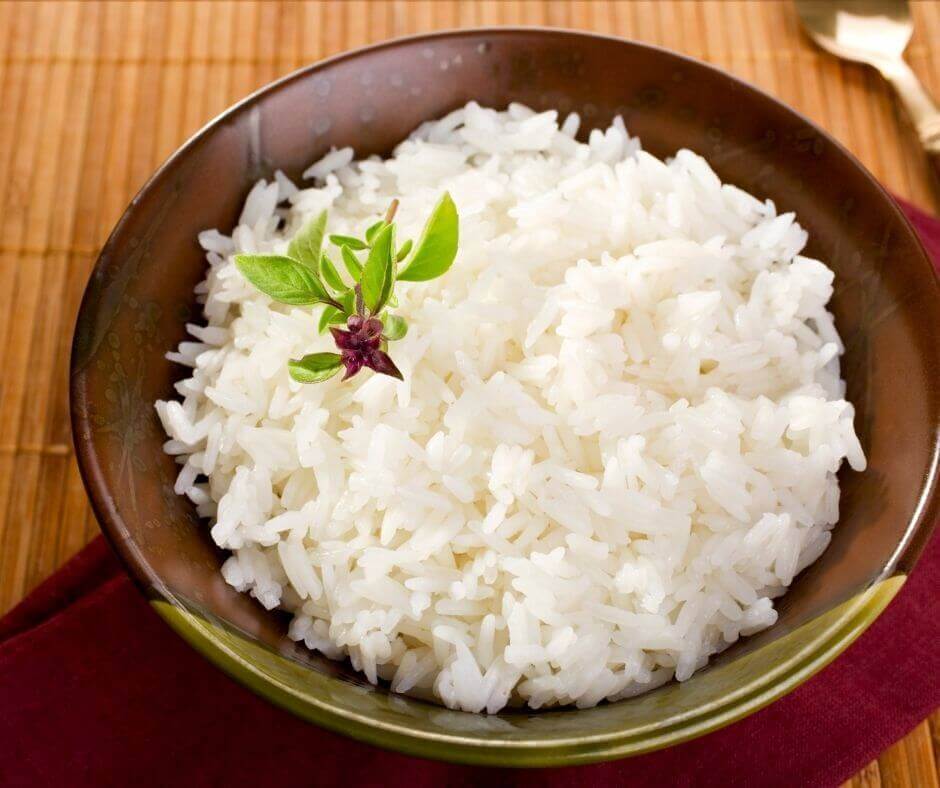White Rice Vs Jasmine Rice: Is Jasmine Rice Healthier Than White Rice?
Is Jasmine rice healthier than white rice and what make exactly makes it healthier? There are some differences in their nutrient levels and other properties that set these two apart from each other. I’ll break down everything you need to know about jasmine rice and white rice, including the differences of nutrients, the different varieties of these two types of rice, precautions, ways to cook them, and more!
Rice is a prominent staple food in many Asian countries. From China to Indonesia, many cultures have foods centered around rice, whether it’s salty or dessert.
White rice is the most commonly used rice grain in the market. White rice has a long shelf life due to advanced processing. The flavor is enhanced in its texture, which is a little nutty if used with less moisture. Its outer body looks shiny due to polishing and attracts the consumers a lot. White rice also has a fair share of its medical benefits on the person’s body.
Thailand is the country in East Asia, home to many different rice species. Jasmine rice is famous rice that belongs to Thailand.
This rice has a long grain and a special aroma. The other variant of Jasmine rice is the brown Jasmine rice that is actually more loaded with nutritional elements than the white Jasmine rice.
Jasmine rice has gained popularity over the years. It is often considered a healthier alternative to its more common counterpart, white rice.

Jasmine Rice:
Jasmine rice is a fragrant rice variety that is available in both short-grain and long-grain formats. It’s named after the town of Jasmine in southern India where it was first grown. When cooked, the rice grains turn translucent and have a distinct aroma of jasmine flowers.
This smell is expectedly the strongest upon removing the lid from your pot. The taste of jasmine rice can be playful and complex if prepared correctly—it’s easy to accidentally over or under cook it and not get that right consistency that you’re looking for.

Nutritional Side of Jasmine Rice:
Jasmine rice has many other useful components that nurture the body and are beneficial to human health in several ways.
As there are 2 main variants of jasmine rice, white and brown. The brown Jasmine rice is more concentrated with nutrients.
The jasmine rice has the following elements in it per 100g
- Carbs 28g
- Proteins 3g
- Fiber 0.8 g
- Sugar 0g
- Fat 0.5g
Checkout The Following 3 Best Jasmine Rice Brands:
Immunity Booster:
The various types of Jasmine rice that are not white ones have a component called Phytonutrients. This helps to make safe the body cells, and the immune system is boosted in this way.
Benefits for New Mothers:
Jasmine rice has traces of folic acid that is useful in pregnancy. It creates a healthy environment for embryo development and is potentially helpful to avoid many complications in the baby.
So it’s good for pregnant ladies to consume an average amount of Jasmine rice if they have no sensitivity issue regarding Jasmine rice usage.
Facilitates Digestion:
Fiber is most prominent in the brown Jasmine rice, and it’s the component that helps strengthen the person’s metabolic system.
Is Jasmine Rice Gluten-Free?
Gluten is a component commonly found in the grains like barley, wheat, etc. It helps to bind the particles of the dough.
It can cause some medical issues in people that are sensitive to it, and Celiac disease is the most common issue related to gluten use.
Gluten can cause hyper-sensitive behavior of the immune system that has an effect on the small intestine.
So the gluten-free diet is a new popular thing these days related to energy-boosting, weight reduction, and mind relaxation.
Originally the Jasmine rice was Gluten-free, but it highly depends on the processing method used for the Jasmine rice.
The solution to this is to read the ingredients before purchasing and always rely on reputable rice brands so you can enjoy your gluten-free rice meal with satisfaction. Is Jasmine Rice Good For Diabetes?
How To Cook Jasmine Rice In A Rice Cooker?
Please note that white rice and jasmine rice follow an identical path of cooking; sometimes, a little time difference occurs in cooking. Usually, this happens if you cook any colored variant of Jasmine rice.
Ingredients:
- 1 Cup Jasmine Rice
- 1.5 Cup Of Water
- 1 Spoon Of Oil Or Butter
Recipe:
- Soak the Jasmine rice in water for about 3 hours before cooking; the more time of soaking, the more good texture it will have.
- Then rinse the rice to remove the extra starch on the surface, put it in the cooking pot, pour measured water in a pot, and add the oil or butter in the water so the rice won’t stick to the bottom of the pool.
- You can add a little salt too to have a salty touch to it and add some chopped veggies or boiled meat to enhance the taste.
- Then cover the lid and choose the rice cooking command on the rice cooker. Nowadays, many rice cookers have advanced features of Jasmine rice, so it’s perfect for selecting that cooker if you are an avid user of jasmine rice.
- It usually takes about 15 minutes to prepare the Jasmine rice, and 10 minutes is the rest time, so the proper texture is attained.
Now enjoy your meal with your loved ones.
Checkout The Following 3 Best Rice Cooker For Jasmine Rice:
White Rice:
Each rice that is white-colored and passed through the milling process is technically called white rice, and so as the case with the white Jasmine rice.
However, sometimes the Jasmine rice is richer in nutrients than the general plain white rice. As per the aroma is concerned, the Jasmine rice has a unique aroma that captures the attention of the foodies.
The health benefits are almost identical for both of these rice. So here comes the challenging part whenever a person wants to choose between 2 of these rice, it’s mostly the taste factor that helps decide which one is to be purchased for the next meal.
As Jasmine rice has slightly more fats than plain rice, the chewy texture and pleasant aroma attract the foodies more.

Benefits of White Rice:
- White rice is especially free from allergy-causing glutens and totally tummy-friendly in nature
- White Rice is Arsenic Free. Due to husk removal, white rice is arsenic-free, so it’s perfect for your health.
- White rice is relatively easy to digest compared to some other types like brown rice, so light on the metabolic system is a plus.
- White rice also contains a sizable amount of carbohydrates and a moderate amount of proteins which are helpful in building muscle and improving hair growth and eyesight betterment if used in a controlled amount.
White rice is enriched with some essential nutrients such as folate and iron etc. Checkout benefit of white Rice.
Checkout The Following 3 Best White Rice Brands:
How To Cook White Rice:
- You can simply cook in the traditional pressure cooker or a rice cooker as per the choice and availability.
- For every cup of white rice, there are about 2 cups of water. It is recommended to soak the rice in water for 20 to 30 minutes before cooking them.
- Then remove the starchy water and then rinse the rice until the water remains clear; this will indicate the removal of starch, so the texture will be preserved and so as the taste.
- Pour the water into the cooking pot, put the white rice in it, cover it with the lid, and press the rice cooker button you are using.
- Please note that plain white rice is normally ready in 20 to 30 minutes, so you have to take that into account.
- Rice cookers made it super easy to cook the tasty white rice with a great texture in tension-free cooking in few minutes.
- When the rice is ready, Rice Cooker auto shift to keep warm mode to preserve the freshness.
Checkout The Following 3 Best Rice Cooker For White Rice:
Which Rice Is More Healthy? White Rice Vs Jasmine Rice
The answer is that both have approximately the same nutritional value. Still, the colored varieties of Jasmine rice (brown and purple, etc.) are generally more energy-rich and, due to more fiber in them, can fulfill the hunger better.
But to choose among them is totally a personal choice that varies from person to person. Both of these rice are good in their regard.
Some Final Words About White Rice Vs Jasmine Rice:
White rice and jasmine rice are both high in carbohydrates and low in protein. Both types of rice also contain extremely low amounts of fat and fiber, but they differ in their micro-nutrient contents. Generally, jasmine rice has a higher concentration of minerals like magnesium and calcium than white rice.
Jasmine rice is the healthier choice, but that’s not saying much because white rice isn’t particularly good for you. Jasmine rice still has its fair share of negatives, like a high amount of arsenic levels, so you should avoid eating it frequently. If you do want to eat jasmine rice from time to time, stick to one serving size (1 cup), and you should be fine. Ultimately, it doesn’t seem that there is any concrete evidence that one type of rice is “healthier” than the other–it really depends on your individual dietary needs.
Reading at this point, you now have the information of Jasmine rice and its close resemblance to white rice. We encourage you to study more and give a chance to both of these rice, and you will love it and always choose the product from a well-renowned brand for your health safety. Cheers!















